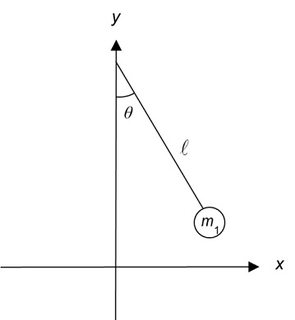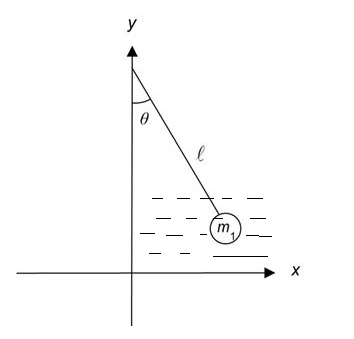
The bob of a simple pendulum performs S.H.M. with period ‘T’ in air and with period ‘\[{T_1}\]’ in water. Relation between ‘T’ and ‘\[{T_1}\]’ is (neglect the friction due to water, density of the material of the bob is $\dfrac{9}{8} \times {10^3}kg/{m^3}$ , density of water =$1g/cc$)
(A) ${T_1} = 3T$
(B) ${T_1} = 2T$
(C) ${T_1} = T$
(D) ${T_1} = \dfrac{T}{2}$
Answer
147k+ views
Hint Consider two cases of time periods. Calculate the effective g and find its relation with g in air. Since given data is in terms of density the mass is converted in terms of density as well. Then substitute the given data to obtain a relation between the two time periods.
Complete step-by-step solution


T and \[{T_1}\]are the time period of the simple pendulum in air and water respectively.
We know that the time period of the pendulum is,
$T = 2\pi \sqrt {\dfrac{l}{g}} $
The length of the pendulum l remains the same in both mediums but g is not the same so we need to consider an effective value
\[{g_e}\] for\[{T_1}\]
\[{g_e}\] is given by the difference between the weight of the bob and the buoyancy force when in water.
${g_e} = \dfrac{{mg - {f_b}}}{m}$
Here,
m is the mass of the bob
g is the acceleration due to gravity
\[{F_b}\] is the buoyancy force= mass of water displaced \[ \times {\text{ }}g\]
Mass is written in terms of density \[\rho \] using the formula,
$\rho = \dfrac{m}{V}$
${g_e} = \dfrac{{\rho Vg - {\rho _1}Vg}}{{\rho V}} = \dfrac{{g\left( {\rho - {\rho _1}} \right)}}{\rho }$
Where,
\[\rho \]is the density of the material of the bob $\dfrac{9}{8} \times {10^3}kg/{m^3}$
\[{\rho _1}\] is the density of water $1g/cc$
On substituting the values,
$
{g_e} = \dfrac{{\left( {\dfrac{9}{8} \times {{10}^3} - 1 \times {{10}^3}} \right)g}}{{\dfrac{9}{8} \times {{10}^3}}} \\
{g_e} = \dfrac{g}{9} \\
$
Since,
${T_1} = 2\pi \sqrt {\dfrac{l}{{{g_e}}}} $
Now, substitute the value of \[{g_e}\] in the above equation, we get,
$
{T_1} = 2\pi \sqrt {\dfrac{{l9}}{g}} = 3\left( {2\pi \sqrt {\dfrac{l}{g}} } \right) \\
\therefore {T_1} = 3T \\
$
Hence, the correct option is A.
Note The pendulum in water displaces some volume so it has to be considered to calculate the time period. Time period is the time taken to complete one oscillation about the mean position. It depends on the medium in which it is oscillating.
Complete step-by-step solution


T and \[{T_1}\]are the time period of the simple pendulum in air and water respectively.
We know that the time period of the pendulum is,
$T = 2\pi \sqrt {\dfrac{l}{g}} $
The length of the pendulum l remains the same in both mediums but g is not the same so we need to consider an effective value
\[{g_e}\] for\[{T_1}\]
\[{g_e}\] is given by the difference between the weight of the bob and the buoyancy force when in water.
${g_e} = \dfrac{{mg - {f_b}}}{m}$
Here,
m is the mass of the bob
g is the acceleration due to gravity
\[{F_b}\] is the buoyancy force= mass of water displaced \[ \times {\text{ }}g\]
Mass is written in terms of density \[\rho \] using the formula,
$\rho = \dfrac{m}{V}$
${g_e} = \dfrac{{\rho Vg - {\rho _1}Vg}}{{\rho V}} = \dfrac{{g\left( {\rho - {\rho _1}} \right)}}{\rho }$
Where,
\[\rho \]is the density of the material of the bob $\dfrac{9}{8} \times {10^3}kg/{m^3}$
\[{\rho _1}\] is the density of water $1g/cc$
On substituting the values,
$
{g_e} = \dfrac{{\left( {\dfrac{9}{8} \times {{10}^3} - 1 \times {{10}^3}} \right)g}}{{\dfrac{9}{8} \times {{10}^3}}} \\
{g_e} = \dfrac{g}{9} \\
$
Since,
${T_1} = 2\pi \sqrt {\dfrac{l}{{{g_e}}}} $
Now, substitute the value of \[{g_e}\] in the above equation, we get,
$
{T_1} = 2\pi \sqrt {\dfrac{{l9}}{g}} = 3\left( {2\pi \sqrt {\dfrac{l}{g}} } \right) \\
\therefore {T_1} = 3T \\
$
Hence, the correct option is A.
Note The pendulum in water displaces some volume so it has to be considered to calculate the time period. Time period is the time taken to complete one oscillation about the mean position. It depends on the medium in which it is oscillating.
Recently Updated Pages
How to find Oxidation Number - Important Concepts for JEE

How Electromagnetic Waves are Formed - Important Concepts for JEE

Electrical Resistance - Important Concepts and Tips for JEE

Average Atomic Mass - Important Concepts and Tips for JEE

Chemical Equation - Important Concepts and Tips for JEE

Concept of CP and CV of Gas - Important Concepts and Tips for JEE

Trending doubts
JEE Main 2025 Session 2: Application Form (Out), Exam Dates (Released), Eligibility, & More

JEE Main Exam Marking Scheme: Detailed Breakdown of Marks and Negative Marking

JEE Main 2025: Derivation of Equation of Trajectory in Physics

JEE Main Participating Colleges 2024 - A Complete List of Top Colleges

Electric Field Due to Uniformly Charged Ring for JEE Main 2025 - Formula and Derivation

Degree of Dissociation and Its Formula With Solved Example for JEE

Other Pages
JEE Advanced Marks vs Ranks 2025: Understanding Category-wise Qualifying Marks and Previous Year Cut-offs

JEE Advanced 2025: Dates, Registration, Syllabus, Eligibility Criteria and More

Units and Measurements Class 11 Notes: CBSE Physics Chapter 1

NCERT Solutions for Class 11 Physics Chapter 1 Units and Measurements

Motion in a Straight Line Class 11 Notes: CBSE Physics Chapter 2

JEE Advanced Weightage 2025 Chapter-Wise for Physics, Maths and Chemistry




